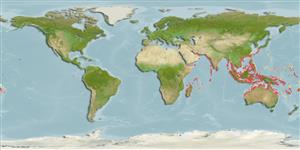Actinopterígios (peces con aletas radiadas) >
Clupeiformes (Herrings) >
Engraulidae (Anchovies) > Engraulinae
Etymology: Encrasicholina: Greek, egkrasicholos, -os, -on = mixed with spleen.
Medioambiente / Clima / Gama
Ecología
; marino; salobre asociado a arrecife; rango de profundidad 1 - 13 m (Ref. 86942). Tropical, preferred ?; 32°N - 28°S, 43°E - 173°W (Ref. 189)
Distribución
Países | Áreas FAO | Ecosistemas | Ocurrencias, apariciones | Point map | Introducciones | Faunafri
Indo-Pacific: widespread in the northern part of the Indian Ocean (Gulf of Aden, but apparently not the Red Sea nor Kenya, the Persian Gulf, India, Andaman Islands) and Western Central Pacific (Indonesia, Thailand, north to at least Taiwan Island, south to northern Australia; also eastward to Fiji and Tonga).
Length at first maturity / Tamaño / Peso / Age
Maturity: Lm ?, range 4 - ? cm
Max length : 8.0 cm SL macho / no sexado; (Ref. 189); common length : 7.0 cm TL macho / no sexado; (Ref. 30573)
Espinas dorsales (total): 0; Espinas anales 0; Radios blandos anales: 15 - 17. Belly rounded with 5 or 6 (rarely 3 or 4) sharp needle-like pre-pelvic scutes. Maxilla tip pointed, projecting beyond second supra-maxilla and reaching to sub-operculum. Isthmus short, preceded by a small bony plate on urohyal between branchial membrane. Unbranched dorsal and anal fin rays. In life, a bright silver band on flank, with a thin blue line above; back blue or grey.
Schooling species. Coastal pelagic (Ref. 68964). Occurs in estuarine and inshore waters. Probably feeds mainly on planktonic crustaceans. Breeds throughout the year, with peaks in New Ireland waters during May to June or July and possibly also in September to November. Eggs are oval, without a knob at one end.
Whitehead, P.J.P., G.J. Nelson and T. Wongratana, 1988. FAO Species Catalogue. Vol. 7. Clupeoid fishes of the world (Suborder Clupeoidei). An annotated and illustrated catalogue of the herrings, sardines, pilchards, sprats, shads, anchovies and wolf-herrings. FAO Fish. Synop. 125(7/2):305-579. Rome: FAO. (Ref. 189)
IUCN Red List Status (Ref. 115185)
CITES (Ref. 94142)
Not Evaluated
Threat to humans
Harmless
Human uses
Pesquerías: escaso valor comercial; carnada: usually
Más información
ReferenciasAcuiculturaPerfil de acuiculturaRazasGenéticaFrecuencias de alelosheritabilidadEnfermedadesProcesamientoMass conversion
Herramientas
Special reports
Download XML
Fuentes de Internet
